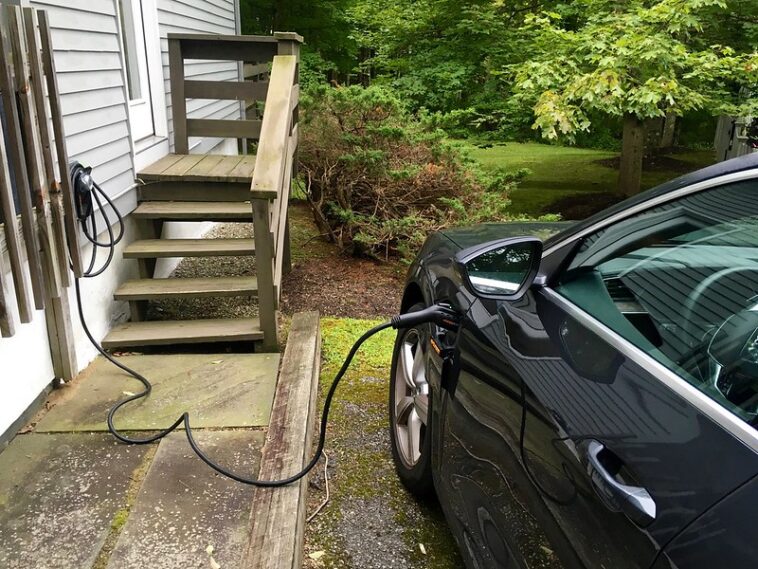For many years now, the climate movement has been focused on megatonnes. In other words, how many tonnes of carbon a policy or project keeps out of the atmosphere in a direct, measurable and cost-effective way. These are important objectives that have helped guide an evidence-based approach to policies such as the carbon tax in British Columbia, which dates back to 2008.
But in the battle of our lifetimes, we’re losing sight of the human element. In Canada’s 2021 election, a top issue driving voters was climate change. In more recent polls in Canada and around the world, climate change has fallen firmly behind issues like housing and the cost of living.
This is despite the fact that 2024 shattered records in insured damage for severe weather events, with 2023 and 2022 right behind it. Halifax flooded, Jasper burned, there were untold damages to crops, highways and basements. And yet, public opinion tells another story.
Top-down regulations focused on reducing megatonnes, while absolutely critical given their wide reach across the economy, are not tangible. They may also be vulnerable to political shifts. By contrast, even under four more years of Donald Trump, America’s Inflation Reduction Act will have made its mark precisely because it invested in the tangible: manufacturing plants in red states, electric vehicles for drivers, and energy-efficiency improvements in millions of U.S. homes.
Yes, we have four more years of Trump to weather. But we also have a bright light for dark times: many clean technologies have become more affordable than their fossil fuel counterparts. In fact, average households in advanced economies will spend less on energy in a net-zero future, according to the International Energy Agency. A Canadian study found a similar result.
But that is too abstract, isn’t it? Net-zero. The year 2050. How about this one: a household in Toronto that today switched its gas cars for electric versions, swapped out its natural gas appliances, installed a heat pump, and made some modest energy-efficiency upgrades would cut $550 off its monthly bill, even taking into account upfront costs. A similar house in Vancouver could save $777. These families would also reduce the carbon footprint of running their cars and homes by more than 90%.
All told, households account for 17% of emissions in Canada. But when you remove Canada’s oil and gas industry from the equation and examine the impact of households at a provincial level, the number is considerably higher in provinces like Ontario, at 30%.
And the real impact is greater still. Consumer growth in EVs is driving rapid technology evolution, in turn making electric motors viable for larger commercial vehicles. Put another way, electric cars get us to electric trucks, electric excavators and a whole lot more. Meanwhile, fossil fuel production, the largest source of emissions in Canada, exists largely to supply fossil-fuel-burning vehicles. Fewer fossil fuel vehicles means less fossil fuel production down the road.
In short, we have greatly underestimated the small but mighty household.
Indeed, the share of energy investments by households has doubled from 9% in 2015 to 18% in 2024 globally, due to growth in rooftop solar installations, investments in building efficiency and EV purchases. In advanced economies with strong policy support, households accounted for nearly 60% of energy-investment growth. This fall, global oil prices fell to a three-year low, largely because of surging EV adoption in China.
Here in Canada, a survey of more than 16,000 EV drivers conducted by the Canadian Automobile Association found that 97% of them were extremely likely or likely to purchase an EV again, while every single concern they had about driving an EV greatly declined after making the switch.
It may also be the case that the more people experience certain clean technologies, the more they will embrace other ones. One U.K. study found that EV drivers were seven times more likely to have both heat pumps and solar panels installed in their homes, while 72% of them had a smart meter to cost-effectively manage their energy use.
In short, this isn’t merely about the emissions of a car. It is just as much about the person who drives it.
In the classic timeline of technology adoption, everything from farming innovation to the iPhone proceeds along a curve. Techie early innovators pilot strange gadgets before their time and preach their benefits. Early adopters may wait until a technology is semi-proven but are still first on their street to set up an EV charger. The coveted demographic is the early majority: people who make decisions based on practical benefits, not coolness. If you get to them, you cross the “chasm” – and mainstream success becomes inevitable.
In some respects, EVs have crossed this threshold. More than half of new cars sold in China are now electric or hybrid, while nearly 100% of new cars sold in Norway are electric. The number is climbing in Canada, too. Canadians claimed more federal EV rebates than ever this October, while rebates claimed during the first half of 2024 doubled compared to the same period last year. It’s yet another indication that EV sales in Canada are growing, not slowing.
Bear in mind, however, that these numbers represent new cars sold, not cars on the road. And while the chasm may already have been crossed in Vancouver and Montreal, for much of Canada, EVs are still outside the mainstream.
Meanwhile, the share of heat pumps installed as primary home heating systems doubled in Canada between 2013 and 2021, increasing from 3% to 6%. Anecdotal evidence suggests they have recently been surging in popularity, but they are not yet the default for most homes. Contrast that with the United States, where heat pumps beat out gas furnace sales two years in a row.
How, then, do we accelerate the adoption wave here in Canada? How do we make EVs and heat pumps gateways to cleaner homes and a cleaner world?
One is a communications challenge: meeting people where they’re at, understanding the challenges they face and the needs they have, while also ensuring they realize the benefits of switching (and yes, there is some misinformation to combat). The second is where all levels of government have an important role to play: reducing the real barriers to adoption that still exist, from higher upfront costs to access to charging.
According to a recent survey, 44% of Canadians are likely to buy an EV as their next vehicle, and this goes up among Canadians aged 30 to 44 (51%) and those in large cities (49%). In other words, among people who are more likely to live in a condo or rent, which means these EV-inclined Canadians also face one of the biggest barriers to EV adoption: a lack of home charging. Through building codes, retrofit incentives and better public charging options, we can unlock the way forward for already-willing future EV drivers.
This is but one of many key areas in need of more attention, but it represents a kind of progress that is more immune to shifting political winds, in part because it connects with people, while every level of government, right down to municipalities, can play an important role.
At first blush, targeting households may not equate to as many megatonnes reduced in a technical model, but in so many other ways, transformation begins at home.
And if there is one lesson our southern neighbours have taught us, it is that in every democracy, power begins and ends with the people. That includes clean power.
This post was co-authored by Trevor Melanson and first appeared in Corporate Knights.




GIPHY App Key not set. Please check settings